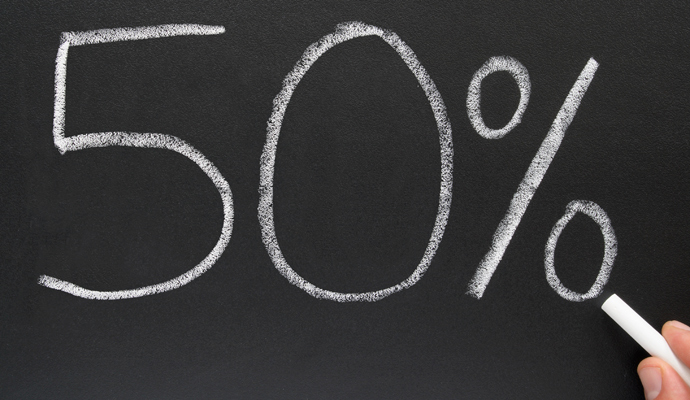The secret behind how I'm saving 40 percent of my income
I embraced — and then dialed back — the 50 percent challenge


I've never been very good at saving.
I'm a spender — shoes, trips, nights out, you name it. It's a fact that became especially apparent to me when I found myself saddled with $10,000 of credit card debt after graduating from college.
Despite this fact, I decided to move to New York City a year later to pursue a career as an actress. The only problem? The minimum payments on my credit cards were so outrageous ($300 a month) that I had to put auditions — and my career dreams — on hold and get a steady, full-time job just to keep up.
The Week
Escape your echo chamber. Get the facts behind the news, plus analysis from multiple perspectives.

Sign up for The Week's Free Newsletters
From our morning news briefing to a weekly Good News Newsletter, get the best of The Week delivered directly to your inbox.
From our morning news briefing to a weekly Good News Newsletter, get the best of The Week delivered directly to your inbox.
As it turns out, I'm great at paying off debt.
I found a job as an administrative assistant at a hedge fund, making $45,000 a year. Between sticking to my budget and putting 30 percent of each paycheck toward my debt, it only took me 14 months to pay it all off.
I celebrated the feat by printing out a screenshot of my zero balance statement to display on the fridge. Having that measure of quantifiable success was empowering, but the truth is that I still hadn't gotten the hang of saving — the one thing that could help keep me out of debt.
The side gig that turned me into a better saver
A free daily email with the biggest news stories of the day – and the best features from TheWeek.com
After living off ramen for much too long, I wanted to experience the "good life" while I still had the chance — but in a city that wouldn't put me back into debt. So after two years of living in New York, I moved to Atlanta to be closer to home and to switch careers. I didn't want to be an actor anymore — or an assistant, for that matter! — and living with my parents seemed like the best place to figure out my next step.
Around the same time, I started a blog. Working at the hedge fund had inspired me to get a handle on my money, and I began writing about the triumphs and pitfalls of working toward financial responsibility. I put all my efforts into the blog — and it ultimately helped me land a job as a content and social media manager for a start-up.
The 50 percent challenge seemed like a good way to aggressively save enough to build up my emergency fund and reestablish solid financial footing again.
Thanks to my blog, I'd come to love thinking, writing, and talking about money — and it inspired me to constantly strive to be more responsible with what I have.
Along with this keen interest in personal finance comes the consumption of a lot of other money-related journalism and ideologies. One of the most interesting? A movement among other bloggers called the "50 percent Club," in which members challenge themselves to put away half their income each month. I loved the idea and hoped that by joining, I'd become a better saver.
My bank account certainly needed a boost: I'd put some of my bonus from my old job (the only "savings" I had to speak of) toward a down payment on my first home in Atlanta, and even though I'd gotten a good deal, it needed a complete renovation — which, of course, went over budget.
The 50 percent challenge seemed like a good way to aggressively save enough to build up my emergency fund and reestablish solid financial footing.

My first month on the 50 percent challenge
Between my full-time job, freelance income from managing social media accounts for a few clients, and advertising revenue from my blog, I take home around $5,200 each month after taxes. Half, or $2,600, seemed like a reasonable enough amount to save each month … until I ran the numbers.
Owning and living in a 2,000-square-foot home by myself means my utilities and insurance premiums are higher than if I lived in an apartment or with roommates. And although the home is much bigger than I need (I originally bought it with my ex), I still need to live here another year or two in order to recoup my investment costs.
So due to a large house and the associated costs, plus such fixed expenses as gas and groceries, I'm shelling out about $2,000 (40 percent of my income) a month before I've even spent any extra "fun" money.
I still wanted to improve my savings habits in a more sustainable way, so I decided to name my own number.
So during my first month on the 50 percent challenge, I tried to trim back on expenses, like utilities and my cell phone bill, but it was tough. The home was old, so it used up a lot of energy. And I needed to use my phone quite a bit for my freelance work.
I also ended up spending my "lifestyle" money a little too freely. After working lots of hours between my full-time job and freelancing, I found it difficult to say no to myself more than usual when I wanted to enjoy my free time or indulge a little.
As a result, I ended up shuffling money back and forth between my checking and savings accounts to cover expenses — and ultimately decided the 50 percent savings challenge just wasn't for me. But I still wanted to improve my savings habits in a more sustainable way, so I decided to name my own savings number.
A retooled money challenge
I started by identifying my biggest money goals and working backward to determine how much I'd need to save in order to meet them.
It was January — a perfect time to think about what I wanted to accomplish by the end of 2014. So I wrote a list: Pay off the last of my lingering house renovation debt ($7,500), increase my emergency fund to $10,000 (five months of living expenses), and fully fund my Roth IRA ($5,500).
Tackling these three goals would cost a total of $23,000 for the year, which was $1,916 a month, or 36 percent of my take-home pay. To make it a nice, even number, I bumped it up to 40 percent, which meant saving only another $144.
Since I'd had trouble saving in the past, I was determined to adopt better habits in order to stay on track this time. I started by vowing to deposit the $1,300 I make each month from freelance work directly into my savings account, so I never see that money or feel it's free to spend. With those funds stashed away, I only need to save another $780 to hit my goal.
I also set up an automatic transfer to my savings account for $340 each pay period — something I'd never done before. And it turns out that I don't really miss that money, either. I know everyone who automates their savings strategy says that, but I've finally learned how true it is!
The best part: Now that I've adjusted my savings number to something I feel more comfortable with, I rarely have to pull money out of savings to cover overages in my discretionary spending.
Even during the months when I miss my goal, I try to remember that it's important to save something — even if it's a small amount.

My new life as a 40 percent saver
With the money I've saved so far, I've been padding my emergency fund, as well as paying off student loans and credit cards that I ran up again while doing renovations.
After I pay off my debt near the end of the year, I'm planning to funnel the funds into my retirement account. Since we're only halfway through 2014, I've focused on paying down debt to save money on interest. It's been really exciting to see these numbers shrink with very little manual effort on my part.
I've also gotten better at saying no to social invitations or home improvement projects if my budget doesn't allow for it. And if I ever need to dip into savings (for emergency car or home repairs, for instance), I try to replace the money the following month.
Hitting the financial targets I've set for myself feels incredible, but perhaps the best thing I've learned from the challenge is not to beat myself up about what I can and cannot do. Some months I've saved closer to 45 percent, and others just 10 percent to 12 percent because an unexpected expense cropped up.
But even during the months when I miss my goal, I try to remember that it's important to save something — even if it's a small amount. I plan to continue to save 40 percent for as long as my lifestyle allows, while also keeping in mind that life can change quickly. Just six months ago, I was saving only around 6 percent of my income.
This story was originally published on LearnVest. LearnVest is a program for your money. Read their stories and use their tools at LearnVest.com.
More from LearnVest...
-
 Antibiotic resistance: the hidden danger on Ukraine’s frontlines
Antibiotic resistance: the hidden danger on Ukraine’s frontlinesUnder The Radar Threat is spreading beyond war zones to the ‘doorstep’ of western Europe
-
 ‘Capitalism: A Global History’ by Sven Beckert and ‘American Canto’ by Olivia Nuzzi
‘Capitalism: A Global History’ by Sven Beckert and ‘American Canto’ by Olivia NuzziFeature A consummate history of capitalism and a memoir from the journalist who fell in love with RFK Jr.
-
 Who will the new limits on student loans affect?
Who will the new limits on student loans affect?The Explainer The Trump administration is imposing new limits for federal student loans starting on July 1, 2026